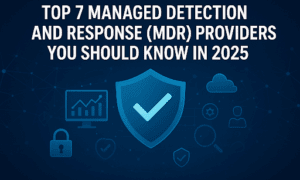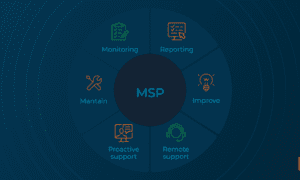No organization can even think about surviving on conventional security tools in this digital-first world, keeping in view the sophistication and frequency of the cyber threat landscape. Firewalls, antivirus, and basic monitoring simply cannot keep up with such dynamic threat landscapes. That is where Managed Detection and Response comes in: it’s more than just monitoring for complete cybersecurity.
MDR combines technological advances with proactive hunting for threats, adding human intelligence into the process. All this amounts to real-time detection, investigation, and response in the end. It’s not about passively monitoring a series of alerts but acting rapidly upon these alerts to prevent potential breaches against your organization before they can cause any damage.
MDR stands for Managed Detection and Response.
Core MDR is a cybersecurity service, accomplishing the tasks of continuous threat monitoring, detection, and active response to cybersecurity incidents 24/7. Basically, the biggest difference between MDR and traditional security monitoring-which usually just notifies an organization about some suspicious activity-is that MDR does more, acting on behalf of such notifications.
MDR solutions continuously analyze network activities using a mix of advanced analytics, AI, machine learning, and human judgment to investigate the root cause of any probable threat that may be detected and immediately contain and neutralize it.
What really sets Managed Detection and Response apart from basic security monitoring, however, is response and remediation. In the case of MDR, your organization doesn’t just get alerted, but it gets a team of cybersecurity professionals who manage and resolve incidents in real time.
Why Monitoring Alone Isn’t Enough
Unfortunately, too many companies think a SIEM system or some other monitoring solution on its own will keep them safe. That’s no longer good enough in today’s cyber threat landscape.
Here is why monitoring alone would not be enough:
● Alert Overload
Most alerts typically are false positives, generated in their thousands every day. Without proper expertise or time, actual threats can easily be overlooked, hidden within this noise.
● No real-time action
Traditional systems of monitoring stop at the detection step because, while they will be able to detect the suspicious activity, they cannot implement an automatic response or mitigation.
● Limited Context and Analysis
While the anomaly detection tool only flags an anomaly, many times it doesn’t explain why it’s occurring or what the potential impact will be. MDR services add contextual insights and expert analysis to make sense of threats.
● Reactive rather than proactive
Whereas monitoring is a generally post-event exercise which can show you what has already happened, MDR is proactive in its essence, hunting for those threats that have not yet cropped up in alerts.
In other words, while monitoring will tell you that there is a problem, MDR fixes problems before they become full-scale security incidents.
The core components of Managed Detection and Response:
The reasons why the MDR is considered a full solution for cyber defense are explained by its basic elements:
● Threat Monitoring 24/7
Remember, cybercriminals do not work on a 9-to-5 schedule, and neither does MDR. In fact, through continuous monitoring, an organization gets enterprise-wide visibility into its systems at any moment of the day or night. MDR providers are able to detect malicious activity in real time across endpoints, networks, and cloud environments using advanced tools.
● Threat Hunting
Unlike traditional monitoring, MDR services include proactive threat hunting: cybersecurity professionals proactively look for hidden, undiscovered threats by applying behavior analytics, threat intelligence, and data correlation. Threat hunters can detect suspicious patterns at their earliest stage that may escalate.
● Incident Response
Rather than just reporting on the detection of a given threat, MDR is all about triggering immediate action. Security teams operating under MDR immediately take action to isolate the affected endpoints, remove malicious files, and neutralize the attacks before the data breaches can take place. That puts dwell time well below levels that can cause serious harm.
● Forensic Analysis and Reporting
After an incident is cleared, it goes for a detailed investigation by the MDR provider to understand the origin, method, and impact of the attack. Forensic analysis will further help enterprises improve their defenses against such incidents.
● Continuous Improvement
Cybersecurity is not an achievement-it’s a process. And so, continuously, MDR services build their detection and response capabilities for emergent threats and newly appearing vulnerabilities. This will make sure the defense is appropriate and effective against the evolution of cyber risks.
How MDR Provides Complete Cyber Defense
The real power of MDR comes in the combination of people, processes, and technology in this multilayered defense system.
● Comprehensive Visibility Across Environments
All estates in view Organizations today are operating on-premise, in the cloud, and hybrid infrastructures. MDR solutions provide complete visibility whereby security teams can keep watch on endpoints, servers, and cloud applications from one console. An expansive view ensures no threat goes unnoticed.
● Faster Detection and Response Speed
This is crucial in cybersecurity, as the larger the time a threat goes undetected, the greater the potential damage. MDR brings down the mean time to detect and mean time to respond drastically because of automation in threat detection and real-time human expertise.
● Expert human analysis
AI is strong but far from perfect. MDR merges AI with expert human judgment. Experienced security analysts review alerts, confirm real threats, and make informed decisions on the ways of handling these threats. The human element actually makes it accurate and effective.
● Scalability and cost efficiency
Only a few organizations can afford to set up an in-house SOC that is staffed 24*7. MDR extends the same or even better protection but at lower costs by outsourcing expertise and infrastructure to specialized providers.
● Compliance with regulations
MDR does continuous monitoring and reporting to enable audit readiness with minimum legal risk for industries bound by GDPR, HIPAA, or PCI-DSS compliance.
Benefits of MDR to Modern Organizations
Choosing the Right MDR Provider
Choosing the right MDR partner is critical to realizing full value from your security investment. Providers should be able to offer:
Conclusion
But MDR is more than a new generation of monitoring; it is the core of modern cyber defense. In an environment where threats are evolving at a pace faster than ever, MDR equips your business with the required speed, intelligence, and expertise to outpace attackers. MDR ties together continuous monitoring, proactive hunting for threats, rapid incident response, and deep analysis to make cybersecurity proactive, not just a reactive function. In a world where organizations need more than security alerts, Managed Detection and Response offers protection from end to end. This is not about threat detection; it is the protection of your business, your data, and your future.



































